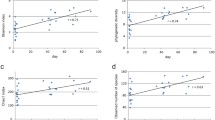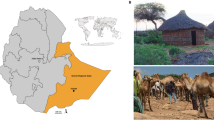Abstract
The sequence of bacterial events that occurs during the colonization of the gastrointestinal tract may affect the future health of the host. A clear understanding of the colonization process of the human neonatal gut in developing countries is lacking because the few available studies were mostly performed using culture techniques. Using molecular approaches, this study analyzed the fecal microbiota of children of low socioeconomic status in São Paulo, Brazil, during their first year of life. We collected fecal samples of healthy children at 3, 6, and 12 months of life. Total DNA was extracted directly from feces, and the bacteria-specific primers 27F-1492R were used to construct 16S rRNA libraries. Clones were randomly selected and partially sequenced. The main phylogenetic groups identified at 3 months were Streptococcus, unidentified bacteria, and Escherichia. At 6 months, Escherichia remained predominant, while the unidentified bacterial population increased significantly. At 12 months, a more complex composition of fecal microbiota was observed, represented by unidentified bacteria and microorganisms found at low rates at earlier ages. The genus Escherichia remained the most abundant microorganism (34 % relative abundance and 75 % prevalence). Principal component analysis (PCA) revealed changes in the composition of the microbiota at 6 months and an increase of diversity at 12 months of life. Bifidobacterium was identified by quantitative PCR (qPCR) and showed a high incidence in the microbiota at 3 months. The present results corroborate the global observation of inter-individual variability with an early establishment of microbial complexity at the end of the first year of life and highlight the presence of the Escherichia as abundant in microbiota composition of this group of children.




Similar content being viewed by others
References
Adlerberth I (2009) Factors influencing the establishment intestinal microbiota in infancy. In: Bier DM, German JB, Lönnerdal B (eds) Personalized nutrition for the diverse needs of infants and children. Nestlé Nutrition Workshop Series 63:13–33
Adlerberth I, Jalil F, Carlsson B, Mellander L, Hanson LA, Larsson P, Khalil K, Wold AE (1998) High turnover rate of Escherichia coli strains in the intestinal flora of infants in Pakistan. Epidemiol Infect 121:587–598
Adlerberth I, Lindberg E, Aberg N, Hesselmar B, Saalman R, Strannegård IL, Wold AE (2006) Reduced enterobacterial and increased staphylococcal colonization of the infantile bowel: an effect of hygienic lifestyle? Pediatr Res 59(1):96–101
Adlerberth I, Wold AE (2009) Establishment of the gut microbiota in Western infants. Acta Paediatr 98:229–238
Azad MB, Konya T, Maughan H, Guttman DS, Field CJ, Chari RS, Sears MR, Becker AB, Scott JA, Kozyrskyj AL, CHILD Study Investigators (2013) Gut microbiota of healthy Canadian infants: profiles by mode of delivery and infant diet at 4 months. CMAJ 185(5):385–394. doi:10.1503/cmaj.121189
Blaut M, Collins MD, Welling GW, Dore J, Van Loo J, De Vos W (2002) Molecular biological methods for studying the gut microbiota: the EU human gut flora project. Br J Nutr 87(2):S203–S211
Brandt K, Taddei CR, Takagi EH, Oliveira FF, Duarte RT, Irino I, Martinez MB, Carneiro-Sampaio M (2012) Establishment of the bacterial fecal community during the first month of life in Brazilian newborns. Clinics 67:113–123
Caicedo RA, Schanler RJ, Li N, Neu J (2005) The developing intestinal ecosystem: implications for the neonate. Pediatr Res 58:625–628
De Filippo C, Cavalieri D, Di Paola M, Ramazzotti M, Poullet JB, Massart S, Collini S, Pieraccini G, Lionetti P (2010) Impact of diet in shaping gut microbiota revealed by a comparative study in children from Europe and rural Africa. PNAS 107:14691–14696
Dominguez-Bello MG, Costello EK, Contreras M, Magris M, Hidalgo G, Fierer N, Knight R (2010) Delivery mode shapes the acquisition and structure of the initial microbiota across multiple body habits in newborn. PNAS 107:11971–11975
Durban A, Abellan JJ, Jimenez-Hernandez N, Ponce M, Ponce J, Sala T, D’auria G, Latorre A, Moya A (2011) Assessing gut microbial diversity from feces and rectal mucosa. Microb Ecol 61:123–133
Eckburg PB, Bik EM, Bernstein CN, Purdom E, Dethlefsen L, Sargent M, Gill SR, Nelson KE, Relman DA (2005) Diversity of the human intestinal microbial flora. Science 308:1635–1638
Edwards CA, Parret AM (2002) Intestinal flora during the first months of life: new perspectives. Br J Nutr 88(1):S11–S18
Fallani M, Amarri S, Uusijarvi A, Adam R, Khanna S, Aguilera M, Gil A, Vieites JM, Norin E, Young D, Scott JA, Dore´ J, Edwards C, the INFABIO team (2011) Determinants of the human infant intestinal microbiota after the introduction of first complementary foods in infant samples from five European centres. Microbiology 157:1385–1392
Favier CF, Vaughan EE, de Vos WM, Akkermans ADL (2002) Molecular monitoring of succession of bacterial communities in human neonates. Appl Environ Microbiol 68(1):219–226
Furet JP, Firmesse O, Gourmelon M, Bridonneau C, Tap J, Mondot S, Doré J, Corthier G (2009) Comparative assessment of human and farm animal faecal microbiota using real-time quantitative PCR. FEMS Microbiol Ecol 68:351–362
Garrett WS, Gordon JI, Glimcher LH (2010) Homeostasis and inflammation in the intestine. Cell 140:859–870
Gibson GR, Roberfroid MB (1995) Dietary modulation of the human colonic microbiota: introducing the concept of prebiotics. J Nutr 125:1401–1412
Hall TA (1999) BioEdit: a user-friendly biological sequence alignment editor and analysis program for Windows 95/98/NT. Nucleic Acids Symp Ser 41:95–98
Hayashi H, Sakamoto M, Benno Y (2002) Phylogenetic analysis of the human gut microbiota using 16S rDNA clone libraries and strictly anaerobic culture methods. Microbiol Immunol 46:535–548
Hayashi H, Sakamoto M, Kitahara M, Benno Y (2003) Molecular analysis of fecal microbiota in elderly individuals using 16S r DNA library and T-RFLP. Microbiol Immunol 47:557–570
Hayashi H, Takahashi R, Nishi T, Sakamoto M, Benno Y (2005) Molecular analysis of jejunal, ileal, caecal and recto-sigmoidal human colonic microbiota using 16S rRNA gene libraries and terminal restriction fragment length polymorphism. J Med Microbiol 54:1093–1101
Lemos LN, Fulthorpe RR, Roesch LF (2012) Low sequencing efforts bias analyses of shared taxa in microbial communities. Folia Microbiol 57:409–413
Li L, Hsiao WW, Nandakumar R, Barbuto SM, Mongodin EF, Paster BJ, Fraser-Liggett CM, Fouad AF (2010) Analyzing endodontic infections by deep association with clinical and histopathologic findings. J Endod 36:1277–1288
Lindberg E, Adlerberth I, Hesselmar B, Saalman R, Strannegard IL, Aberg N, Wold AE (2004) High rate of transfer of Staphylococcus aureus from parental skin to infant gut flora. J Clin Microbiol 42(2):530–534
Ludwig W, Strunk O, Westram R, Richter L, Meier H, Yadhukumar, Buchner A, Lai T, Steppi S, Jobb G, Forster W, Brettske I, Gerber S, Ginhart AW, Gross O, Grumann S, Hermann S, Jost R, Konig A, Liss T, Lussmann R, May M, Nonhoff B, Reichel B, Strehlow R, Stamatakis A, Stuckmann N, Vilbig A, Lenke M, Ludwig T, Bode A, Schleifer KH (2004) ARB: a software environment for sequence data. Nucleic Acids Res 32:1363–1371
Lundequist B, Nord CE, Winberg J (1985) The composition of faecal microflora in breastfed and bottle fed infants from birth to eight weeks. Acta Paediatr Scand 74:45–51
Marchesi JR, Sato T, Weightman AJ, Martin TA, Fry JC, Hiom SJ, Wade WG (1998) Design and evaluation of useful bacterium-specific PCR primers that amplify genes coding for bacterial 16S r RNA. Appl Environ Microbiol 64:795–799
Mariat D, Firmesse O, Levenez F, Guimaraes V, Sokol H, Dore J, Corthier G, Furet JP (2009) The Firmicutes/Bacteroidetes ratio of the human microbiota changes with age. BMC Microbiol 9:123
Mello RM, Morais MB, Tahan S, Melli LC, Rodrigues MS, Mello CS, Scaletsky IC (2009) Lactobacilli and bifidobacteria in the feces of schoolchildren of two different socioeconomic groups: children from a favela and children from a private school. J Pediatr 85:307–314
Montesi A, Albiach RG, Pozuelo MJ, Pintado C, Goñi I, Rotger R (2005) Molecular and microbiological analysis of caecal microbiota in rats fed with diets supplemented either with prebiotics or probiotics. Int J Food Microbiol 98:281–289
Nicholson JK, Holmes E, Kinross J, Burcelin R, Gibson G, Jia W, Pettersson S (2012) Host-gut microbiota metabolic interactions. Science 336:1262–1267
Novak FR, Almeida JA, Vieira GO, Borba LM (2001) Colostro humano: fonte natural de probióticos? J Pediatr 77:265–270
Nowrouzian F, Hesselmar B, Saalman R, Strannegar IL, Aberg N, Wold AE, Adlerberth I (2003) Escherichia coli in infants’ intestinal microflora: colonization rate, strain turnover, and virulence gene carriage. Pediatr Res 54(1):8–14
Palmer C, Bik EM, Digiulio DB, Relman DA, Brown PO (2007) Development of the human infant intestinal microbiota. PLoS Biol 5:e177
Penders J, Thijs C, Vink C, Stelma FF, Snijders B, Kummeling I, Van Den Brandt PA, Stobberingh EE (2006) Factors influencing the composition of the intestinal microbiota in early infancy. Pediatrics 118:511–521
Pruesse E, Quast C, Knittel K, Fuchs BM, Ludwig W, Peplies J, Glockner FO (2007) SILVA: a comprehensive online resource for quality checked and aligned ribosomal RNA sequence data compatible with ARB. Nucleic Acids Res 35:7188–7196
Rastall RA (2004) Bacteria in the gut: friends and foes and how to alter the balance. J Nutr 134:2022S–2026S
Ricucci D, Siqueira JF Jr (2010) Biofilms and apical periodontitis: study of prevalence and coverage pyrosequencing. J Dent Res 89:980–984
Roger LC, Mccartney AL (2010) Longitudinal investigation of the faecal microbiota of healthy full-term infants using fluorescence in situ hybridization and denaturing gradient gel electrophoresis. Microbiology 156:3317–3328
Salminen SJ, Gueimonde M (2005) In: O. Hernell, J. Schmitz (eds) Feeding during late infancy and early childhood: impact on Health. Vevey/S. Karger AG, Basel. Nestlé Nutr Workshop Ser Pediatr Program 56:43–56
Schloss PD, Westcott SL, Ryabin T, Hall JR, Hartmann M, Hollister EB, Lesniewski RA, Oakley BB, Parks DH, Robinson CJ, Sahl JW, Stres B, Thallinger GG, Van Horn DJ, Weber CF (2009) Introducing mothur: open-source, platform-independent, community-supported software for describing and comparing microbial communities. Appl Environ Microbiol 75:7537–7541
Sekirov I, Russell SL, Antunes LC, Finlay BB (2010) Gut microbiota in health and disease. Physiol Res 90:859–904
Strausberg RL, Levy S, Rogers YH (2008) Emerging DNA sequencing technologies for human genomic medicine. Drug Discov Today 13:569–577
Tanaka S, Kobayashi T, Songjinda P, Tateyama A, Tsubouchi M, Kiyohara C, Shirakawa T, Sonomoto K, Nakayama J (2009) Influence of antibiotic exposure in the early postnatal period on the development of intestinal microbiota. FEMS Immunol Med Microbiol 56:80–87
Tannock GW (2001) Molecular assessment of intestinal microflora. Am J Clin Nutr 73:410S–414S
Vrieze A, Holleman F, Zoetendal EG, De Vos WM, Hoekstra JB, Nieuwdorp M (2010) The environment within: how gut microbiota may influence metabolism and body composition. Diabetologia 53:606–613
Wang Q, Garrity GM, Tiedje JM, Cole JR (2007) Naive Bayesian classifier for rapid assignment of rRNA sequences into the new bacterial taxonomy. Appl Environ Microbiol 73:5261–5267
Yatsunenko T, Rey FE, Manary MJ, Trehan I, Dominguez-Bello MG, Contreras M, Magris M, Hidalgo G, Baldassano RN, Anokhin AP, Heath AC, Warner B, Reeder J, Kuczynski J, Caporaso JG, Lozupone CA, Lauber C, Clemente JC, Knights D, Knight R, Gordon JI (2012) Human gut microbiome viewed across age and geography. Nature 486:222–227
Zoetendal EG, Collier CT, Koike S, Mackie RI, Gaskins HR (2004) Molecular ecological analysis of the gastrointestinal microbiota: a review. J Nutr 134:465–472
Acknowledgements
Financial support—FAPESP 08/53959-5 and 2011/51196-7 (Fundação de Amparo à Pesquisa do Estado de São Paulo) to CRT.
Author information
Authors and Affiliations
Corresponding author
Rights and permissions
About this article
Cite this article
Taddei, C.R., Oliveira, F.F., Duarte, R.T.D. et al. High Abundance of Escherichia During the Establishment of Fecal Microbiota in Brazilian Children. Microb Ecol 67, 624–634 (2014). https://doi.org/10.1007/s00248-014-0381-x
Received:
Accepted:
Published:
Issue Date:
DOI: https://doi.org/10.1007/s00248-014-0381-x




